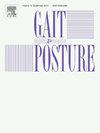Within-session dual-task walking practice improves gait variability in older adults with multiple sclerosis
IF 2.2
3区 医学
Q3 NEUROSCIENCES
引用次数: 0
Abstract
Background
Greater gait variability is associated with falls in aging and multiple sclerosis. However, whether older adults with MS (OAMS), show higher gait variability relative to healthy older adults (HOA), under single and dual-task walking conditions, has not been reported. Furthermore, it is unclear whether practice may improve gait variability in both groups.
Research question
Is gait variability higher in OAMS relative to HOA, particularly in DTW compared to STW? Furthermore, does practice result in decreased gait variability in both groups, notably under DTW compared to STW?
Methods
We examined the effect of within-session practice on gait variability during single (STW) and dual (DTW) task gait conditions. OAMS (n = 97, mean±SD age: 65 ± 5 years, 66 females) and HOA (n = 113, mean±SD age: 68 ± 7 years, 73 females) were recruited. Practice effects on gait variability were evaluated over three repeated counterbalanced STW and DTW trials. Gait variability measures included Coefficient of Variation (CV) in stride velocity, stride length, and swing time.
Results
OAMS demonstrated higher gait variability, on all measures, relative to HOA during both STW and DTW (P < 0.001). Gait variability on all measures was higher in DTW compared to STW, (P < 0.05). Practice resulted in decreased gait variability (P < 0.01) on all measures in both OAMS and HOA. Furthermore, practice resulted in decreased temporal gait variability, as measured by swing time CV, under DTW in particular (P < 0.05).
Significance
In conclusion, OAMS exhibited greater gait variability than HOA, yet both groups demonstrated decreases in temporal and spatial gait variability after within-session practice, notably under DTW, which in turn may reduce fall risk.
双任务步行练习可改善多发性硬化症老年人的步态变异性
背景:更大的步态变异性与衰老和多发性硬化症的跌倒有关。然而,在单任务和双任务行走条件下,老年多发性硬化症(OAMS)是否比健康老年人(HOA)表现出更高的步态变异性,尚未有报道。此外,尚不清楚练习是否可以改善两组人的步态变异性。研究问题:与HOA相比,OAMS患者的步态变异性是否更高,尤其是与STW相比,DTW患者?此外,练习是否会降低两组的步态变异性,特别是在DTW与STW相比?方法研究了单步和双步任务步态条件下训练对步态变异性的影响。纳入OAMS (n = 97,平均±SD年龄:65 ± 5岁,女性66例)和HOA (n = 113,平均±SD年龄:68 ± 7岁,女性73例)。通过三个重复的平衡STW和DTW试验来评估练习对步态变异性的影响。步态变异性测量包括步幅速度、步幅长度和摇摆时间的变异系数(CV)。结果在STW和DTW期间,相对于HOA, soams表现出更高的步态变异性(P <; 0.001)。与STW相比,DTW组的步态变异性在所有测量中都更高,(P <; 0.05)。在OAMS和HOA的所有测量中,练习导致步态变异性降低(P <; 0.01)。此外,通过摆动时间CV测量,特别是在DTW下,练习导致时间步态变异性降低(P <; 0.05)。综上所述,OAMS比HOA表现出更大的步态变异性,但两组在训练后的时间和空间步态变异性都有所降低,特别是在DTW下,这反过来可能降低跌倒风险。
本文章由计算机程序翻译,如有差异,请以英文原文为准。
求助全文
约1分钟内获得全文
求助全文
来源期刊

Gait & posture
医学-神经科学
CiteScore
4.70
自引率
12.50%
发文量
616
审稿时长
6 months
期刊介绍:
Gait & Posture is a vehicle for the publication of up-to-date basic and clinical research on all aspects of locomotion and balance.
The topics covered include: Techniques for the measurement of gait and posture, and the standardization of results presentation; Studies of normal and pathological gait; Treatment of gait and postural abnormalities; Biomechanical and theoretical approaches to gait and posture; Mathematical models of joint and muscle mechanics; Neurological and musculoskeletal function in gait and posture; The evolution of upright posture and bipedal locomotion; Adaptations of carrying loads, walking on uneven surfaces, climbing stairs etc; spinal biomechanics only if they are directly related to gait and/or posture and are of general interest to our readers; The effect of aging and development on gait and posture; Psychological and cultural aspects of gait; Patient education.
 求助内容:
求助内容: 应助结果提醒方式:
应助结果提醒方式:


